16 Best Trimarans For Sailing Around The World (And a Few For Daysailing)

As an Amazon Associate, we earn from qualifying purchases. We may also earn commissions if you purchase products from other retailers after clicking on a link from our site.
Trimarans are growing in popularity worldwide, due to their light construction and high stability these multihulls are even faster than catamarans. Trimarans are still one of the lesser-known boat types so in this article ill be checking out some of the most popular models.
The best trimarans include:
- The Neel 43
- The Neel 47
- Dragonfly 28
- The Pulse 600
- Corsair 37
These tris are built with your safety in mind while also packing powerful speed and a wide array of comfort features to optimize your sailing experience , some are even foldable making them possible to load on a trailer and transport to the sailing destination of your choosing.
In this article, I have created a list of the 16 best trimarans in the market and their unique features. You’ll also learn the best options for different purposes such as circumnavigation, weekend sailing, racing, and more.
Table of Contents

What Is a Trimaran?
A trimaran is a multi hulled sailboat with three individual hulls; the main hull ( vaka ) and a pair of outrigger hulls ( amas ). These smaller outrigger hulls are attached to the main hull using beams.
While trimarans have a rich history dating back nearly four millennia, these types of sailboats have only gained popularity in the late 1900s and early 2000s.
Trimarans are primarily used as personal boats for sailing enthusiasts or racing. These sailboats draw their versatility from their lightweight design, making them faster and easier to handle at sea when compared to single-hulled boats (monohulls). Additionally, the three hulls also contribute to better stability, making it very hard to capsize (although more likely than a cat according to this study)
Trimarans come in various sizes, and some can be as small as 19 feet (5.8 meters) in length, while others go up to 60 feet (18meters). They’re also used for different purposes. Most trimarans are used for racing and recreational purposes, although some units are still used as ferries.
As with all things, to find out which is the best we need to understand what it will be used for. There is a big difference in requirements between a boat used for day sailing compared to offshore around the world sailing.
The list below highlights the best trimarans for different purposes.
Best Trimarans For Cruising, Liveaboard and Sailing Around The World
The Neel 43 is a French trimaran best suited for cruising. Its key features include:
- Easy maneuverability on the open sea by only a small number of crew members
This unit is also built for comfort, ideal for more extended travels. This 43-feet (13-meter) trimaran is also made with recyclable and bio-sourced materials, highlighting the manufacturer’s commitment to environmental consciousness.
This trimaran has a base price of €329,000 excluding VAT. This translates to approximately $370,138.
2.Neel 47 Possibly The Best
Named the best full-size multihull for 2020, the Neel 47 is a strong contender for one of the best trimarans in the market. This 47-foot (14.3-meter) long trimaran features optimized exterior and interior ergonomics for a unique design and look.
Still on design, the Neel 47 is ideal for couples looking to take a weekend off or spend some time as liveaboard. It has a spacious owner’s cabin and two bedrooms. It also features a spacious living room and kitchen and is optimized to ensure comfort for a couple.
The Neel 47 also has two basic guest cabins so your friends or children can tag along on your sailing adventure. Accordingly, this unit is ideal for those looking to explore the sea for the sheer joy of sailing.
The Neel 47 comes at a 571,139 euro ( $643,600 ) price tag, excluding VAT.
3. Rapido 60 The Fast and Comfortable Circumnavigator
The Rapido 60 offers a blend of performance, safety, and luxury, making it one of the best options for bluewater sailing. Measuring 59.3 feet (18 meters) in length, the Rapido 60 is an imposing unit. It’s made from lightweight sandwiches and carbon materials that provide speed and strength, allowing it to stand up to strong ocean currents.
The Rapido 60 also has spacious living spaces and is built for comfort at all points of the sail. Its design also optimizes safety. While it’s an ideal option for circumnavigating, it’s also an excellent choice for racing due to its speed.
This is also the same boat that The Youtube channel La Vagabond just purchased.
The Rapido 60 retails at $1,400,000 .
4. Rapido 40
The Rapido 40 measures 39.4 feet (12 meters) in length and is ideal for cruising around the world. The Rapido 40 features twin “C” foils, which provide added lift, enhancing its speed and performance whether you are sailing downwind or upwind.
Because it has C foils, this trimaran doesn’t have a central daggerboard, increasing interior space. Accordingly, it’s an excellent option for couples looking to cruise and enjoy great performances .
The Rapido 40 is made from high-tech all-carbon materials for a lightweight yet sturdy design. This material is also used for the countertops and furniture, and the cork flooring adds a touch of style.
This trimaran retails for $595,000 , making it a cheaper option than the Rapido 60.
5. Dragonfly 40
The Dragonfly 40 measures 40 feet (12 meters) in length. It features high-comfort standards, making it one of the best trimarans in the market for taking your family for a cruise. Because of its larger size, it has a better capacity, being capable of accommodating six to eight people, so you can bring your family and friends along.
It’s easy to navigate and extremely safe. With a maximum speed of 24 knots (44.5 km/h), this trimaran also provides fast speeds to make your cruise even more exhilarating.
The Dragonfly 40 retails from €509,000 exclusive of VAT, which rounds up to $572,000 .
6. Dragonfly 32
The Dragonfly 32 is a high-performance cruiser. Like the Dragonfly 28, this unit features a contemporary design for racing. This trimaran can accommodate five to seven crew members.
Although slightly longer than the Dragonfly 28 with its 32-foot (9.8-meter) length, the Dragonfly 32 has a max speed of 23+ knots (42.6+ km/h), making it one of the fastest trimarans for racing. This unit also has comfortable accommodation, which makes it an ideal option for a weekend cruise with family and friends.
The Dragonfly 32 has a base price of $350,000 .
7. Corsair 37
Thanks to a variable draft with a retractable rudder, the Corsair 37 is an ideal choice for shallow water exploration. This 37-foot (11.3-meter) long trimaran features advanced foam-cored construction designed for safety, making it virtually unsinkable.
The carbon hulls minimize weight, this makes for a lightweight ocean exploration sailboat with blistering speeds. One of its selling points is that this trimaran has previously been used for Arctic expeditions, possibly marking it as one of the better options for circumnavigation and offshore sailing in the northern waters.
This trimaran has a base price of $189,000 but can go up to $204,125 .
Best Trimarans For Day/Weekend Sailing
8. dragonfly 28.
The Dragonfly 28 is a 28-feet (8.75-meter) long sailboat that can accommodate up to five people. It comes in two versions:
- Touring version: This version is ideal for families.
- Performance version: This is built to provide optimal performance for the sports enthusiast within you.
It clocks a maximum speed of 22+ knots (22+ km/h) and is beam-folded. It’s an excellent option if you want a high-performance, comfortable yet smaller unit for your day or weekend cruise.
The Dragonfly 28 starts at €188,280 inclusive of VAT, which comes to around $211,600.
9. Dragonfly 25
Like other trimarans under the Dragonfly brand, this 25-foot (7.62-meter) trimaran is great for both racing and short term cruising. However, this high-performance boat delivers easy handling, making it perfect for couples looking to take a ride out over the weekend and seasoned sailors looking for an exhilarating racing adventure.
The Touring version features a lightweight build and offers comfort and accommodation to keep you, and the few guests you can fit, comfortable during the ride. This trimaran also has a Sport version, which is optimized for racing.
The Dragonfly 25 retails from EUR 86,800 .
10. Pulse 600
The Pulse 600 trimaran is a compact sailboat. It’s made from lightweight, carbon-reinforced construction and vacuum-formed materials for optimal speed. This trimaran is an ideal option if you are looking for speed.
It also features ample deck space, greater stability, and volume than most trimarans of similar size and build.
This trimaran measures 19.8 feet (6 meters) in length and can be sailed single-handedly by one person with minimal effort. The Pulse 600 has a base price of $38,800 , which places it in the lower price range.
The F-22 is one of the smaller trimarans in the market. Developed in New Zealand, the F-22 is a folding trimaran built for speed. The hulls are made from narrow fiberglass tied together using fiberglass beams and aluminum, minimizing bulk while optimizing speed.
The F-22 is roomy and is not as pricey as other models in the market. This trimaran has two main versions:
12. 2019 Weta Trimaran
The 2019 Weta trimaran is a 14.5-foot (4.4-meter) trimaran featuring a carbon frame, centerboard, rudder foil, and rudder shock. The hull is made from fiberglass and foam. The Weta is built for strength and speed based on these lightweight materials.
The 2019 Weta trimaran is easy to sail and is worth considering whether you want to take a quiet sail, race with your friends, or take kids to a sailing lesson. It has a simple design and is easy to set up independently. Thanks to its collapsible design, this trimaran is easily stored away with minimal space demands.
13. WindRider 17
The 17.4-foot (5.3-meter) WindRider 17 is one of the more versatile trimarans in the market. It packs high performance for a low cost. This trimaran has a light rotating mast to boost performance, and a full-battened mainsail optimizes visibility.
This sailboat is made from rotomolded polyethylene, which is more durable than fiberglass and demands less maintenance.
The WindRider 17 has a comfortable interior and can fit six adults. This is an ideal choice for social sailing for a couple or a family and friends. It’s easy to ride, and a shallow draft allows easy maneuverability.
14. Astus 22.5
If you’re looking for something small but still comfortable, this 22.5-foot trimaran is for you. Built for speed and maneuverability, the Astus 22.5 has optional foils to optimize speed. The modern design, coupled with the spacious interior, can fit up to four beds. Accordingly, this trimaran is suited for family outings.
This trimaran also has a foldable design, collapsing to only 16 feet (4.9 meters) for easy storage.
15. Multi 23 Trimaran
The Multi 23 trimaran has a contemporary design, featuring a vinyl ester and PVC foam core construction. The section below the waterline is made of solid glass for a sturdy base.
The beams are made of lightweight carbon, and the trimaran features a 33-foot (10-meter) aluminum rotating wing mast for optimal harnessing of the wind. While ideal for weekend excursions with family, once rigged with the asymmetrical spinnaker will get your heart pumping.
This trimaran packs high performance at a lower cost than most other options in the market. It’s a good choice if you are looking for a high-performing unit without spending an arm and a leg.
16. Challenger Class Trimaran
The Challenger Trimaran 15 is the best choice for persons with disabilities. It’s designed to provide disabled sailors an opportunity to explore their passion for sailing without worrying about aspects like safety or operation.
A man named Geoff Hold circumnavigated the British Isles in 2007, becoming the first disabled person to achieve this feat. He had quadriplegia.
Living up to its name, the Challenger can withstand harsh weather conditions while blending performance with speed.
Final Thoughts
Admittedly, no trimaran is best for everyone. But whether you are looking to race with your friends, take your loved ones or friends for a cruise over the weekend, or circumnavigate the ocean, you can rest assured that these lightweight trimarans will deliver speed, safety, and comfort to make it worth your while.
These brands are innovatively designed and feature intricate safety mechanisms that make them virtually unsinkable. Give them a shot and begin your ocean adventure.
- Basco Boating: A Comprehensive Guide & Introduction to Trimaran Yachts
- TheBoatAPP: New Trumarans: Which are the Best Ones
- Corsair Marine: Corsair 37
- Dragonfly: Dragonfly 28
- Rapido Trimarans: Rapido 60
- Neel Trimarans: Neel 43
- Yachting World: World’s Collect Yachts: Maxi Trimaran MACIF
- Yachting Monthly: Dragonfly 28 Performance
- Rapido Trimarans: Rapido 40
- Dragonfly: Dragon 32
- Dragonfly: Dragonfly 40
- Yachting World: Dragonfly 40 yacht tour: This cruising trimaran can do 24 knots
- Dragonfly: Dragonfly 25
- NauticExpo: Dragonfly 25
- Yachtworld: Corsair 37 boats for sale
- Cruising World: Neel 47 Trimaran: Best Full-Size Multihull0
- Neel Trimaran: Neel 47
- Multihull Solutions: NEEL 47 Boat Review | Cruising World
- Yacht World: 2022 Neel 47 for sale
- Farrier International: F-22
- Weta Marine: The Boat
- WindRider: WindRider 17 Trimaran Sailboat
- Astus Boats: Astus 22.5
- Boat-specs: Multi 23
- National Maritime Museum Cornwall: Challenger Trimaran #1 – BC26
Owner of CatamaranFreedom.com. A minimalist that has lived in a caravan in Sweden, 35ft Monohull in the Bahamas, and right now in his self-built Van. He just started the next adventure, to circumnavigate the world on a Catamaran!
Leave a Reply Cancel reply
Your email address will not be published. Required fields are marked *
Save my name and email in this browser for the next time I comment.
Recent Posts
Must-Have Boat Gear for Catamaran Sailors!
Sailing is probably the most gear-intensive activity I've ever done; there are so many decisions to be made about what gear to buy now, for tomorrow, and what to definitely never buy. The gear on...
6 Best Trailerable Trimarans For Bluewater and Coastal Sailing
Having a boat costs a lot of money, even when you are not using it, marina fees, etc. And once it is in the water most sailors never go very far from their "home marina" and sailing will be somewhat...
- Vanquish 65
- Mini Maniac
- RG65 Appendages
- Maniac MK II
- IOM Appendages
- Marblehead Class
- Marblehead Appendages
- RT65 Ragnarok
- RT65R Armageddon
- RC65 Adrenaline
- ST65 Sowelu
- Mini40 / F48 Class
- Nightmare X
- Nightmare MK VIII
- MultiOne Class
- FireDragon 1000
- DIY Sail Winch
- Rig Building

Click the pictures to expand

Browse the pictures using the slider, click the center picture to expand

Browse the pictures using the slider, click the center picture to view the video clip.
- Performance
- Construction
- NEEL 43 PERFORMANCE limited edition
- Rental-Management
- Charter a NEEL trimaran
- LEEN-TRIMARANS
- NEEL-TRIMARANS GROUP
- NEEL OWNERS COMMUNITY
Receive an offer
Rent a NEEL

Racy look, fast and voluminous
With its racy, modern silhouette, elaborately designed hull and sleek lines, the neel 52 exudes power, speed, and elegance. moving inside and on the deck is smooth and safe., photos and videos, neel 52 sailing, it boasts remarkable seaworthiness, performance (both sailing and motoring), and comfort. she is easily handled by a small crew. the hulls of neel trimarans combine a central 'rockered' hull, which facilitates tacking and manoeuvring when in port, with streamlined floats that provide stability and prevent pitching..

NEEL 52 exterior
The neel 52 features the renowned cockloon® , an impressive interior/exterior living space made possible by the wide opening between the cockpit and the saloon. it also incorporates the full beam cockpit®, an extra-wide cockpit with multiple seating configurations that can be rearranged to take full advantage of the different vistas..

NEEL 52 interior
The living space on one level is highly ergonomic and entirely open plan, offering exceptional luminosity. the kitchen and the chart table face forwards. the panoramic view from this huge saloon is breathtaking. both elegant and simple, the decoration lends the neel 52 a look of timeless distinction and gives the ample living space a calming atmosphere..

Choose your layout
Either a 4 cabin layout with a single deck cabin (2 options are shown here: port side forepeak sleeping area and 2 crew cabins) .
Or, a 5 cabin layout with a single deck cabin (one option is shown on this plan: 2 crew cabins)

Either 4 lower cabins (3 options are illustrated here: port side forepeak in bed + starboard side forepeak in bed + 2 crew cabins)
Or, 6 lower cabins (Shown here is the crew cabin option)
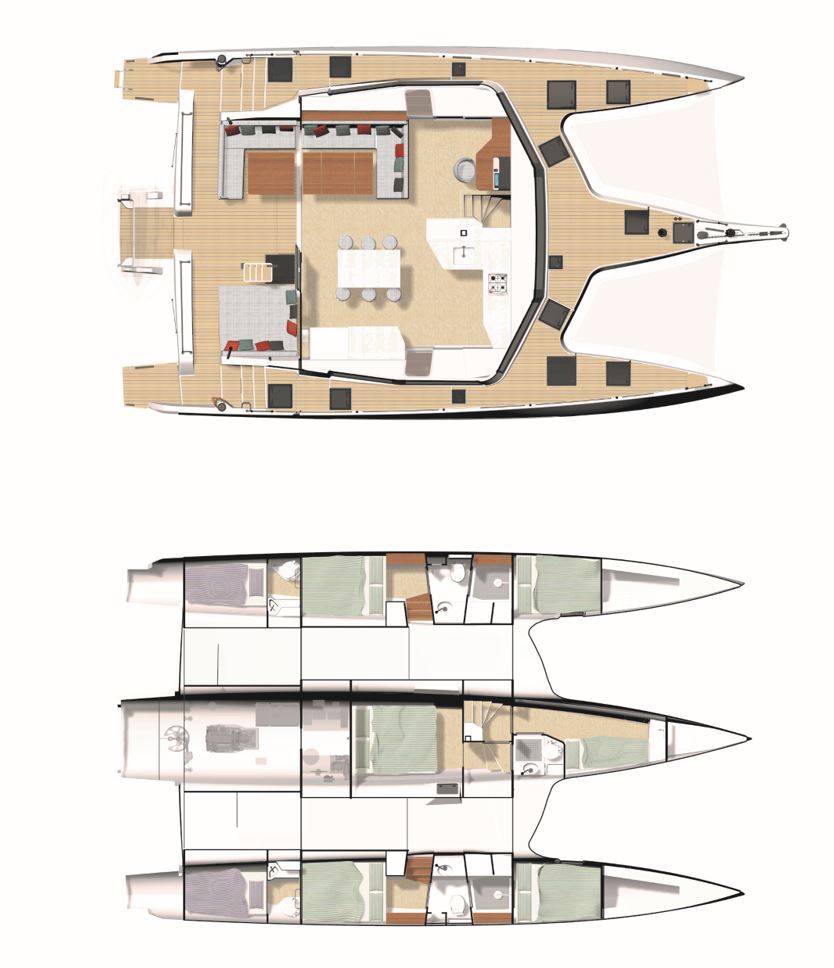
Specifications

Privacy Overview
- Legal Notice
- Recruitment
- Private access
- BOAT OF THE YEAR
- Newsletters
- Sailboat Reviews
- Boating Safety
- Sails and Rigging
- Maintenance
- Sailing Totem
- Sailor & Galley
- Living Aboard
- Destinations
- Gear & Electronics
- Charter Resources
- Ultimate Boating Giveaway


Neel 47 Trimaran: Best Full-Size Multihull
- By Herb McCormick
- Updated: December 9, 2019
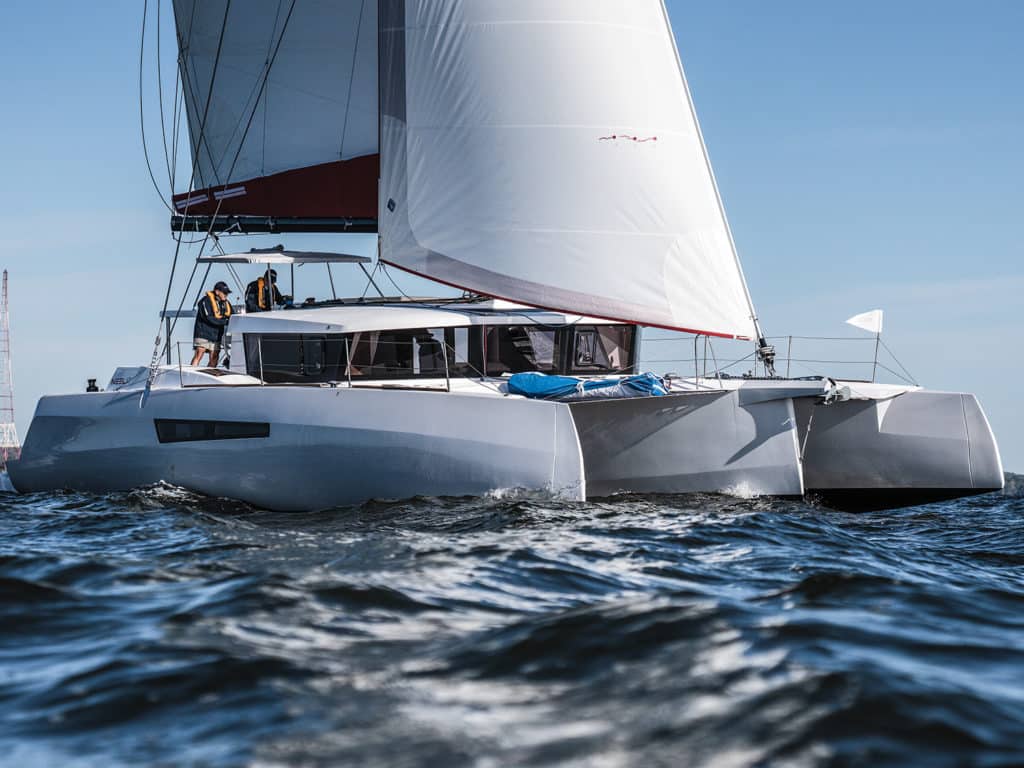
It’s hard to imagine three vessels, in a single class, as different in layout, purpose and execution than the trio of multihulls that comprised the year’s Best Full-Size Multihull class. Two of the three were catamarans, and the third a most unusual craft: a cruising trimaran. Sorting out these unique boats was a challenge.
The multimillion-dollar Eagle Class 53—built in Rhode Island to exacting standards and a radical design brief (with potential foiling capability and a solid wing mast that also incorporates a “soft” mainsail on its trailing edge)—was not, in any manner, a contemporary cruising boat. Yes, there is a pair of cabins with doubles aft, and the central living space includes a workable galley and one other notable feature. “It’s the only boat we sailed that even had a full bar on deck with slide-out seats sitting on carbon fiber: custom-made carbon-fiber pods,” panelist Ed Sherman said. “I mean, it’s just an amazing piece of workmanship. I don’t know what else to say. It’s a cool boat.” And while it would be a reach to call the Eagle 53 a cruiser, it was certainly remarkable and couldn’t be ignored, which is why the judges were unanimous in separating it for special recognition.
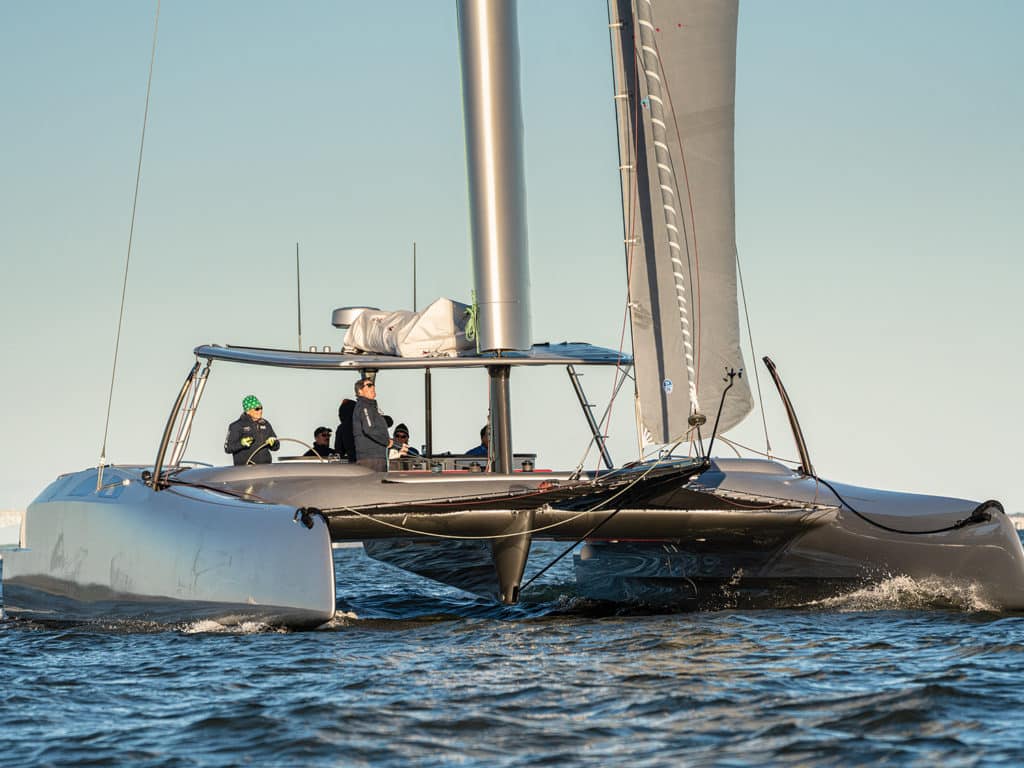
What it thus came down to was which of the two remaining boats—the Bali 5.4 cat and the Neel 47 tri—best addressed or met its stated design briefs. The 55-plus-foot Bali certainly has offshore bona fides—the boats are delivered across the Atlantic from the boatyard in France where they’re crafted—but the yacht is most definitely laid out for steady work (and parties) in the charter trade. The final deliberations were lively.
The first thing that struck judge Dan Spurr was the unusual sailing experience, with the steering station situated on a flybridge well above the waterline. “It felt like a floating island and kind of sailed like one, I thought,” he said. “Being so high above the water, even though we were doing well in light air and making 5 or 6 knots, it was almost hard to tell whether we were moving.”
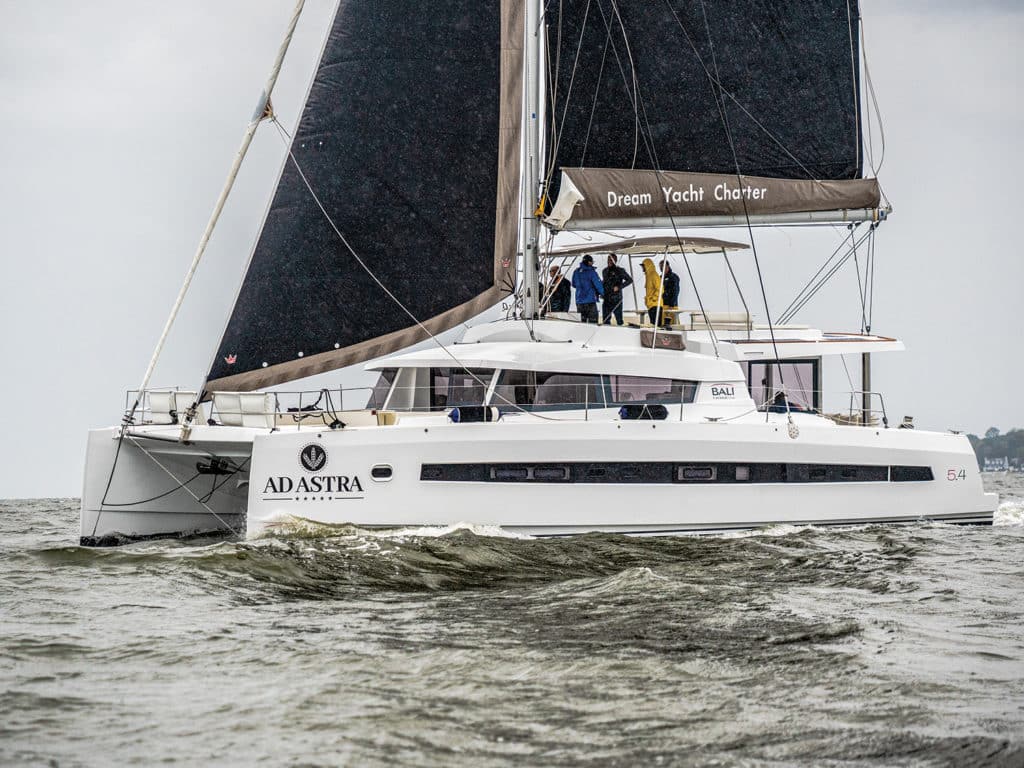
His fellow judge Ralph Naranjo concurred. “The main boom on the Bali is probably 15 or 16 feet high,” he said. “You’re giving away a lot of the foot of the sail, and you’re sticking the masthead up a lot farther in the sky to get the same kind of drive. At anchor in warm climates in areas where you sail flat and don’t have too much of a seaway, boats like this certainly fit the bill. And the Bali was an extreme version of that. The idea of doing an ocean passage up there aloft seems like a tiring situation.”
“Under sail, the motion of the Neel through the water was very comfortable.”
“I was actually pleasantly surprised that the boat sailed better than I thought it would, and by a significant margin,” Sherman said. “And let’s not forget the chartering equation that’s a big part of this boat’s aura. The way it’s equipped and laid out down below, it’s built for calm seas and a bunch of friends to have one hell of a good time.”
In some ways, that describes the reasoning behind what happened next. Viewing it as the better layout and configuration for serious cruising, the judges conferred the title of Best Full-Size Multihull on the Neel 47 . For the BOTY 2020 awards, three hulls proved better than two.
“The Neel 47 is a very interesting boat—the only trimaran in our collection, which has quite a bit of significance just from a design perspective because it enables them to get all of their heavy gear and machinery in that center hull,” Sherman said. “In terms of balance, it’s a great way to go. Under sail, the motion of the boat through the water was very comfortable. It’s a unique concept with the interior layout in that the owner’s stateroom is at deck level with these giant picture windows overlooking the horizon, and the guest cabins are aft and in the amas. So even though we have a 47-footer here, it’s really a couple’s boat, though there is room for occasional guests.”
“The trend of late in cruising multihulls has certainly been toward cats, so I appreciated their efforts to make a cruising trimaran,” Spurr said. “There’s a real trade-off—the fundamental one being I believe you’re going to get better performance with a trimaran, but you’re going to sacrifice accommodations. So I feel that for most of the buying public, they’re going to have to be leaning toward the performance end of the spectrum. The main owner’s cabin on the saloon level is kind of fun and interesting, but it’s adjacent to the galley and entertaining areas. So, I agree with Ed that this is a boat aimed at an experienced couple.”
Those couples who go with a Neel will be going with a winner.
See All Winners:
2020 Boats of the Year
Other Winners:
- Overall Boat of the Year
- Best Performance Cruiser
- Best Midsize Cruiser Under 45 feet
- Best Full-size Cruiser
- Best Full-size Cruiser Over 55 Feet
- Best Midsize Cruising Catamaran
- Best Full-size Multihull
- Best Charter Boat
- Most Innovative
- More: boty , boty 2020 , Sailboats
- More Sailboats

By Sail Or Paddle: Meet the 17′ Salish Voyager

Introducing the Allures 51.9

Beneteau’s First 30 is Here

Sailboat Review: Hallberg-Rassy 40C

Sailing Camp Empowers Kids on the Autism Spectrum

For the Greater Good: 50 Years, Going Boldly

Couples Cruising: Making His Dream Ours
- Digital Edition
- Customer Service
- Privacy Policy
- Terms of Use
- Email Newsletters
- Cruising World
- Sailing World
- Salt Water Sportsman
- Sport Fishing
- Wakeboarding

| 18th International exhibition for yachts and boats | |
| Dates: Thursday, February 27, 2025 - Sunday, March 2, 2025 | |
| Venue: Crocus Expo IEC, , | |
| | | | |
| International exhibition of boats and yachts Moscow Boat Show is the leading event for representa-tives of the yachting business, professionals of the branch and numerous fans of yachts, boats and water sports. The impressive exposition features a wide range of products including motor and sailing yachts, boats, electric boats, electric motors, helicopters, design trimarans, pontoons, components, diving equipment and outfit and other related items. The visitors have an opportunity not only to see the exhibits but to get also consultation of highly qualified specialists. | |
| Website: | |
| | | | | |
| Mezhdunarodnaya str. 16, 18, 20, Krasnogorsk, Krasnogorsk area, Moscow region, Moscow Tel: +7-495-727-2626 | |||
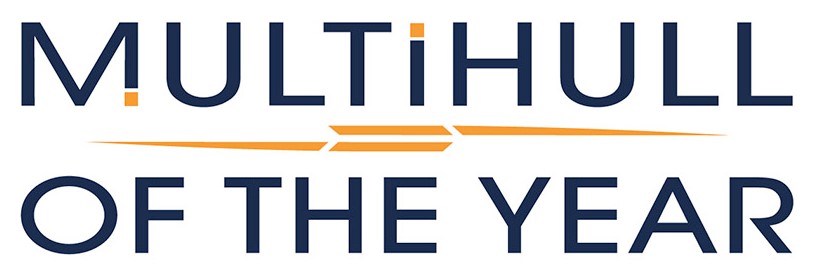


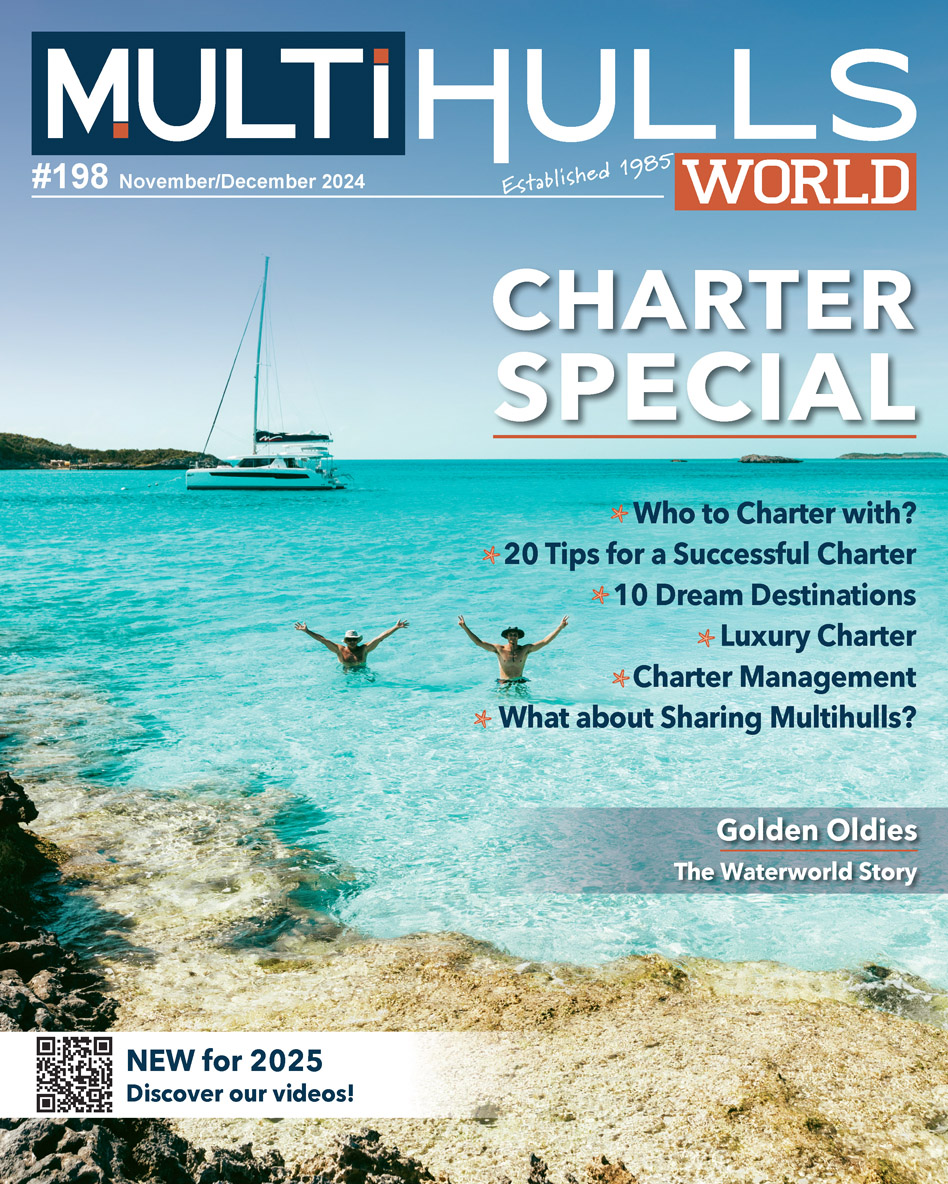








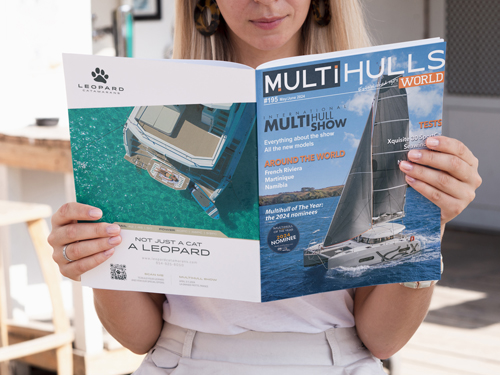



IMAGES
VIDEO
COMMENTS
Who Bought Kevin Costner's Trimaran? Articles 2024 Sail Buyer's Guide From 30 to 40 feet Articles from the same dossier. Articles 2025 Multipower Buyer's Guide Over 70 feet ... Bali 4.3 Special sailing edition Location : Mali Losinj, Croatia Year : 2019 520 000, 00 Ex. tax€ Power catamaran Fountaine Pajot Greenland 34 - fully self ...
Passat Trimaran Sailing Edition. Fram: McPherson, krängningshämmare. Bak: Multilänkaxel med krängnings-hämmare. Elekromekanisk servostyrning. Säkerhets-rattstång av teleskoptyp. ABS med elektronisk bromskraftsfördel-ning EBF. Skivbromsar fram och bak, ventilerade fram samt bromsassistent. ** Preliminära värden.
Who Bought Kevin Costner's Trimaran? Articles 2024 Sail Buyer's Guide From 30 to 40 feet Articles from the same dossier. Articles 2025 Multipower Buyer's Guide 30 to 40 Feet ... Bali 4.3 Special sailing edition Location : Mali Losinj, Croatia Year : 2019 520 000, 00 Ex. tax€ Power catamaran Fountaine Pajot Greenland 34 - fully self ...
Orphie 29 - Pocket-Size Electric Trimaran Test in MW183. ILIAD 53S - Boat Review Teaser Test in MW196. MAKAI M37 - Boat Review Test in this issue. ... Bali 4.3 Special sailing edition Location : Mali Losinj, Croatia Year : 2019 520 000, 00 Ex. tax€ Power catamaran Fountaine Pajot Greenland 34 - fully self-sufficient Location : Toulon ...
Passat Variant BlueMotion 1.6 TDI 105 DPF Specs: 2009: 105 hp / 77 kW: 1598 cm 3 (97.5 cu-in) Latest Car Specs. 2024 Lotus Emeya Base. 2024 Lotus Emeya S. 2024 Lotus Emeya R. 2024 Audi Q6 e-tron quattro. 2024 Audi Q6 e-tron SQ6 quattro. 2024 Alfa Romeo Junior Elettrica 156 .
Trimarans are a little easier, with a single central daggerboard to act as a pivot, and one or other of the floats will generally be clear of the water. On the downside, light displacement means that there isn't much momentum to keep you going through the turn and plenty of windage to stop you. Speed is your friend.
This trimaran retails for $595,000, making it a cheaper option than the Rapido 60. 5. Dragonfly 40. The Dragonfly 40 measures 40 feet (12 meters) in length. It features high-comfort standards, making it one of the best trimarans in the market for taking your family for a cruise.
Neel 47 trimaran Jon Whittle . There's no question that the Neel 47, designed by the ubiquitous, performance-oriented French naval architect Marc Lombard, was an outlier in this year's Boat of the Year contest. After all, it was the lone trimaran in the fleet of a half-dozen multihulls, the other five being cruising catamarans.
The Nightmare is designed to be able to sail on one float, it is a stable design which is not pitch poling easily. Look the pictures and the video clips of our boats. Free plans for the MK VII and the MK VIII can be downloaded here. Boat Data: - hull lenght 1200mm without front fender. - beam 1210mm. - epoxy-fiber glass floats , weight about ...
The T-2000 Voyager is an all-weather powercat dedicated to exploration and extreme sailing, was treated. To begin with, its performance is particularly breathtaking: over 50 knots of top speed and a record range of 3,000 miles at 9 knots. ... Who Bought Kevin Costner's Trimaran? Articles 2024 Sail Buyer's Guide From 30 to 40 feet Articles ...
The NEEL 52 features the renowned Cockloon® , an impressive interior/exterior living space made possible by the wide opening between the cockpit and the saloon.It also incorporates the Full Beam Cockpit®, an extra-wide cockpit with multiple seating configurations that can be rearranged to take full advantage of the different vistas.
Cruising World Judges named the Neel 47 trimaran the Best Full-Size Multihull for 2020. In the large multihull class, at least for 2020, the Neel 47 proved that three hulls are better than two. The Eagle Class 53 was easily the most unique boat in the long history of Boat of the Year. Jon Whittle. It's hard to imagine three vessels, in a ...
Farrier, who passed away in 2017, created the F-22 as a kind of culmination of all he'd continued to learn about small, trailerable multihulls in the years since he penned the F-27 trimaran, a true trail-blazer and now part of the "Sailboat Hall of Fame.". Another F-22 sidles up alongside a pier in Malta with amas folded in.
Manufactured by a variety of yacht building companies, there are currently 161 trimaran yachts for sale on YachtWorld, with 52 new vessels for sale, and 109 used and custom yachts listed. These vessels are all listed by professional yacht brokers and boat dealerships and new boat dealers, mainly in the following countries: United States, France ...
Dates: Thursday, February 27, 2025 - Sunday, March 2, 2025. Venue: Crocus Expo IEC, Moscow, Russia. International exhibition of boats and yachts Moscow Boat Show is the leading event for representa-tives of the yachting business, professionals of the branch and numerous fans of yachts, boats and water sports. The impressive exposition features ...
Who Bought Kevin Costner's Trimaran? Articles 2024 Sail Buyer's Guide From 30 to 40 feet Articles from the same dossier. Articles 2025 Multipower Buyer's Guide 50 to 60 feet ... Bali 4.3 Special sailing edition Location : Mali Losinj, Croatia Year : 2019 520 000, 00 Ex. tax€ Power catamaran Fountaine Pajot Greenland 34 - fully self ...
We would like to show you a description here but the site won't allow us.
In bar 92, Scriabin plays b on the second beat in the right hand, as was printed in the first edition, rather than g sharp - an alteration made in later editions to bring the phrase into uniformity with its other appearances. But Scriabin's b avoids collision with the left hand's tenor part (music example 4). Mus. ex. 4.
Bali 4.3 Special sailing edition Location : Mali Losinj, Croatia Year : 2019 520 000, 00 Ex. tax€ Lagoon 470 Location : Sainte Anne 97180 Guadeloupe, France Year : 2005 350 000, 00 Ex. tax€ NAUTITECH OPEN 40 IN VERY WELL STATE AND WELL EQUIPPED FOR THE BIG CRUISE Location : PAPEETE, French Polynesia
Op. 63, 2 Poèmes. In the second of these short works, some l. h. notes in the chords in b. 6 and 7 have been erased; these notes are relocated to the upper stave, where they belong musically, and marked m.g.(The m.d. in bar 7 is a characteristic slip, rightly questioned by the editor).The top note of these chords is shown in the manuscript as f natural and was so published in the RMI edition.